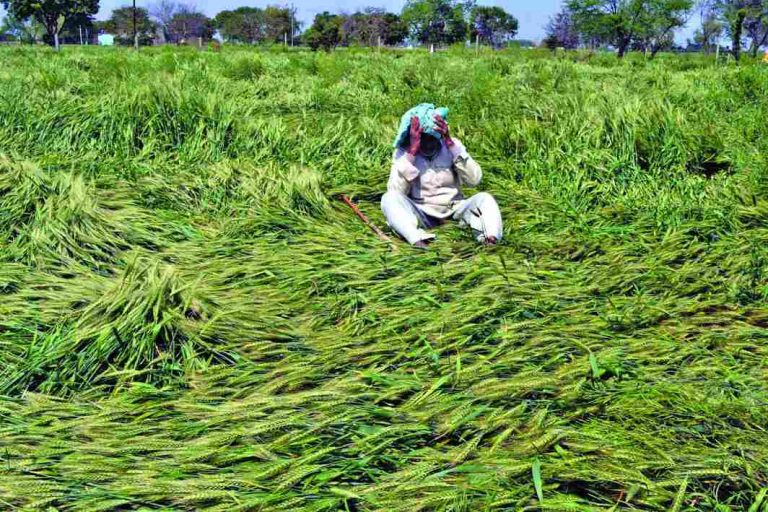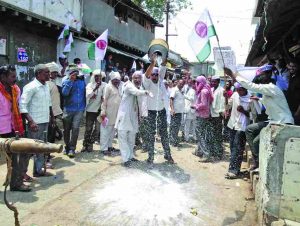
The simmering anger among farmers led to huge loan waivers. But this would impoverish the state governments. Instead, they should check the volatility in prices and have policies to improve farmer incomes
~By Vivian Fernandes
Farmers’ unrest has taken various state governments by surprise and they have bent over backwards to placate them with huge loan waivers (see box). Because of bumper harvests and near-normal rainfall, prices crashed, leaving farmers at their wits’ end. While normalcy has been restored in Madhya Pradesh after 10 days of violent farmer protests, Mandsaur, where five farmers were killed in police firing, is limping back to life. Four farmers also committed suicide in Vidisha, Sehore, Raisen and Hoshangabad district within 48 hours in June.
While MP Chief Minister Shivraj Singh Chouhan had initially refused to engage with farmers, he was so rattled later that he went on a two-day tour of Mandsaur and half-a-dozen adjoining villages. He also opened the purse strings of the exchequer to give Rs 1 crore each to the relatives of those killed. According to an official estimate, 193 government and 122 private vehicles were torched and shops, factories and houses were damaged. In all, property worth Rs 70 crore was destroyed.

Though farmer suicides have been an ongoing feature in various states for years now, what should not be forgotten is the sheer distress that drives them to do so. As per the 2016 National Crime Records Bureau data, at least three farmers killed themselves every day in MP. The government confirmed that at least 1,695 farmers and agricultural labourers committed suicide from February 1 to mid-November last year.
In all, there have been at least 18,687 suicides by farmers in MP between 2001 and 2015. Crop failure and the inability to sell the produce profitably and repay loans were the major reasons.
While things have cooled down in MP, the threat of disruption persists as the Rashtriya Kisan Mazdoor Sangh (RKMS), which spearheaded the stir, is not done yet. Its leader Shiv Kumar Sharma is defiant. For four days, MP farmers dumped milk and vegetables on roads. But Chouhan’s government was unmoved. Only when clashes in Sehore, Indore and Bhopal districts left six policemen injured on June 4 did the government act.

But it tried to engineer a spilt in the ranks of the protesters by talking only to the Bharatiya Kisan Sangh, which is affiliated to the RSS. Chouhan said his “pro-farmer government” had accepted 11 of 13 demands, including a fund of Rs 1,000 crore to purchase farm produce during price slumps. But it has not given in on debt relief and the assurance of remunerative prices. MP’s 60 lakh farmers are indebted by about Rs 60,000 crore. The government’s refusal to accept these two demands and the secret deal with the BKS infuriated Sharma. On June 5, over a thousand farmers gathered at Pipaliya in Mandsaur, 350 km from Bhopal, and indulged in arson and hooliganism. Such incidents were also reported from Neemuch, Ratlam and Dhar districts. The police shot dead five farmers at Pipaliya when it failed to control the violence.
Demonetisation forced farmers to obtain agri-inputs on credit from traders, who in turn forced them to sell the produce soon after harvest at very low rates.
The unrest is particularly embarrassing for Chouhan as MP is an agriculturally vibrant state. It had won the Krishi Karman award in April for highest production of wheat during 2015-17, for the fifth year in a row. Agricultural economist Ashok Gulati had held the state as a model for Uttar Pradesh to emulate. Investment in rural roads, the completion of 1,400 minor dams bringing 4.8 million hectares under irrigation between 2009 and 2014, uninterrupted power supply during the wheat season and assured procurement had boosted the state’s agri-gross state domestic product by an average of 9.7 percent a year from 2005-06 to 2014-15, the highest among states, and three times that of UP (3.2 percent), he said.

From June 10, the price stabilisation fund which Chouhan announced is being used to buy onions at Rs 8 a kg in the Mandsaur and Ratlam areas. These are sold for Rs 2 a kg in areas where onions are not grown, said Kuldeep Shukla, CEO of the Jabalpur Agri Producer Company, a farmer producer organisation, which procures for the government for a fee. Both the state and central governments are buying black gram (urad) and green gram (mung bean) as well. These are short-duration summer crops grown after the rabi harvest and before kharif sowing. For urad, the support price is Rs 5,225 a quintal against the market price of around Rs 3,500. For mung bean, the rates are Rs 5,006 and Rs 3,800 respectively.
Ironically, Chouhan’s order that mandi purchases cannot happen below minimum support prices has caused traders to go on strike. Allowances will have to be made for poor quality, they say. Shukla says of the 30 farmers who brought mung bean for sale to him, 21 had to be rejected as their produce was below fair average quality.
In Maharashtra, simmering discontent flared up when onion prices dived. The gram panchayat of village Puntamba in Ahmednagar district passed a resolution calling upon the government to agree to a charter of eight demands, failing which farmers would strike from June 1 and disrupt supplies of vegetables, fruits and milk to cities. Other villages joined in.
The opportunity was too good for opposition parties like the Congress and the NCP to miss. The Shiv Sena, never happy with the ruling BJP, did its bit to annoy its ally. The announcement of a farm loan waiver for UP farmers by Yogi Aditynath, soon after being sworn in on March 19 had a contagion effect. Maharashtra CM Devendra Fadnavis, who had said he would give agri-inputs free instead of debt relief, had to capitulate in the face of disrupted supplies. On June 11, he announced a huge loan waiver of Rs 35,000 crore for farmers.
But Ganesh Nanote, a farmer in Nimbhara village in Akola district, said: “We do not want loan waivers, we only want good rates.” A graduate in commerce, Nanote owns 15 acres and cultivates a variety of crops. He was smart enough to sell about 60 quintals of pigeon pea (tur) to the central government’s procurement agency, Nafed, soon after harvest for Rs 5,050 a quintal when market prices had fallen to Rs 3,500 to 4,000 a quintal. The eight-month crop cost him about Rs 1,800 to produce, so he made a profit of round Rs 2 lakh. He sold cotton for around Rs 5,000 a quintal, of which half was profit. But he took a hit on the four-month soybean crop.
Strangely, these protests took place despite agriculture doing well in various states. But farmers do not measure their well-being by praises for making the country food secure or the size of heaps at grain mandis. For them, the gauge is the swell of currency notes in their pockets and by that yardstick, the last financial year was less-than-cheerful. This was despite the 2016 monsoon season seeing “normal” rainfall and kharif being a season of plenty. Residual soil moisture blessed the rabi harvest as well.
According to an official estimate of the MP government, 193 government and 122 private vehicles were torched and shops, factories and houses were damaged.
Food grain production, estimated at 273 million tonnes during 2016-17, was the highest so far. Pulse production increased by a third to 22.40 million tonnes. This was enough fodder for agriculture minister Radha Mohan Singh to brag about the success of his initiatives. But circumstances played a spoiler.
Take the case of Gulbarga mandi in north Karnataka where the signs of good cheer were evident earlier this year. The arrivals of pigeon pea spoke of a harvest blessed by favourable weather and low incidence of pests and disease attacks. About 5,035 quintals had arrived on January 12 when this correspondent visited it, against 3,405 quintals the same day the previous year. But expanded supply has dampened prices. The weighted average rate in the Gulbarga yard that day was Rs 4,326 a quintal against Rs 9,536 a year ago. At Yadgir market, about a 100 km away, the price of red tur was Rs 4,526 a quintal—a drop of more than 50 percent a year ago.
Due to the fall in prices, there was brisk procurement by Nafed under the Price Stabilisation Fund set up in March 2015 to curb volatility in the prices of commodities like pulses, onions and potatoes. The centre had offered to buy pigeon pea at Rs 4,500 a quintal. The state government has thrown in a bonus of Rs 450. Many farmers camped over-night to be early birds. But it obviously wasn’t enough.

In 2014-15, inclement weather had crimped the output of pigeon pea. How-ever, higher prices had more than compensated for this. The rates ranged between Rs 15,700 and Rs 4,600 a quintal in the Gulbarga mandi, the weighted average price for the year being Rs 9,617. A little over eight lakh quintals had arrived that year. Arrivals the previous year were nearly 20 lakh quintals, forcing the weighted average price to fall to Rs 4,900 a quintal.
Given the high prices prevailing in 2015-16, agricultural universities like the one at Parbhani in Marathwada had advised farmers to cultivate the pulses crop. But it had not reckoned with overproduction.
Take the case of kharif pulses. Their output was 8.6 million tonnes, of which about 2 million tonnes were procured. Yet, 60 percent of “record tur output was sold at less than the minimum support price, resulting in depressed income,” Chief Economic Adviser Arvind Subramanian said at a recent lecture.
“The government is not able to procure more because it has no space to store,” said B Venkateswarlu, vice-chancellor of Parbhani University. Even private mills have their limitations, he said.
In Telangana and Andhra Pradesh too, chili farmers took to the streets as prices fell from a peak of Rs 12,000 a quintal in 2015-16 to Rs 3,000-4,000 in the last week of April as new acreages resulted in massive overproduction. Chili is unprofitable below Rs 6,000 a quintal, Venkateswarlu said, as the price does not even cover the cost of picking. Angry farmers blocked highways and set fire to heaps of chili, forcing the central government to announce it would step in and buy 1.22 lakh tonnes.

Apart from the contagion effect of debt relief in Uttar Pradesh, the demonetisation of Rs 500 and Rs 1,000 notes had a ripple effect on farm incomes. The drive to replace old currency notes with new ones forced farmers to obtain agri-inputs on credit from traders, who in turn forced them to sell the produce soon after harvest at very low rates and repay the loans.
While state governments have brought temporary peace with farm loan waivers, it is not a lasting solution. Subramanian says less than 50 percent of small and marginal farmers (those owning less than 5 acres) borrow from banks. Their finances strained, states will have to cut back on investments in rural infrastructure like irrigation and roads, which will deny farmers insurance against deficient rainfall and easy access to markets.
What generosity!
Various state governments have waived off loans to farmers based on political expediency. According to a Bank of America Merrill Lynch report, various state governments in India are expected to waive off loans to farmers amounting to Rs 2,57,000 crore in the run-up to the 2019 general elections. This amount covers almost 2 percent of India’s GDP. Over the years, state governments have waived off huge loans:
- The UP government waived loans of Rs 36,359 crore taken by about 94 lakh small and marginal farmers. Loans amounting to Rs 5,630 crore taken by seven lakh farmers whose accounts were declared as NPAs by banks were also included
- In Chhattisgarh, the government announced Rs 3,200 crore as interest-free loan to the farmers this fiscal year
- In Maharashtra, Devendra Fadnavis announced a loan waiver of Rs 36,359 crore to small and marginal farmers
- Rajasthan gave loans worth Rs 44,000 crore to farmers in the last three years and aims to increase this to Rs 70,000 crore in the next two years
- In MP, widespread protests and violence in Mandsaur forced the government to announce a farm loan settlement of Rs 6,000 crore
- Last year in Tamil Nadu, the late CM J Jayalalithaa waived loans of 16.94 lakh marginal and small farmers who owned less than five acres of land, causing a financial burden of Rs 5,780 crore to the state exchequer
- In Telangana, the K Chandrashekar Rao-led TRS government in 2014 waived crop loans of Rs 17,000 crore as part of its poll promise
- In Andhra Pradesh, N Chandrababu Naidu promised a loan waiver of Rs 1.50 lakh crore to farmers before the state elections in 2014. But banks refused the proposal

The unrest among farmers also calls for a shift in emphasis from production to marketing. While productivity will have to improve so that more can be produced from less land at a lower cost, farmers will have to get better value. Venkateswarlu said crop planning will be needed based on likely weather conditions and trends in demands and supply. It is a proposal which Kuldeep Shukla endorses. By managing the sale of seeds, public agencies on whom most farmers depend, can regulate the area under crops, he says.
Contract farming should be pushed so that farmers can concentrate on production. Permitting FDI in retailing might help. Trade policy will also have to keep the interests of farmers in mind and not just that of consumers. The government is ever-ready to impose stocking limits and export curbs to force prices down, but it does little to help farmers when prices slump.
“Why is there an outcry among urban consumers whenever prices rise? They should eat less when commodities are scare,” said Nanote. Consumers will cry when prices pinch, but expecting farmers to subsidise them by taking a hit on their incomes is unfair.
—With Rakesh Dixit in Bhopal

